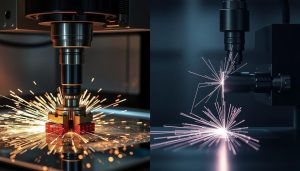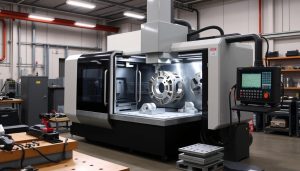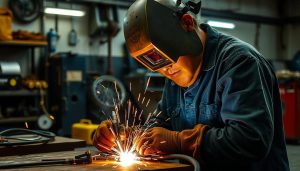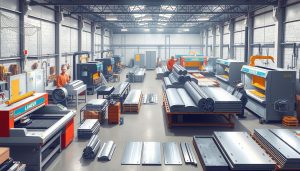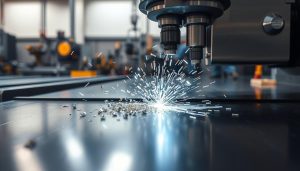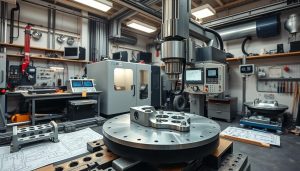In the world of precision manufacturing, Electrical Discharge Machining (EDM) has emerged as a crucial technology, offering versatile solutions for complex and intricate parts. Two main types of EDM processes stand out: Sinker EDM and Wire EDM. Understanding the key differences between these techniques is essential for selecting the right approach for your manufacturing needs.
Sinker EDM, also known as Die-Sinking EDM, utilizes a shaped electrode to erode the workpiece, creating complex three-dimensional (3D) shapes with remarkable accuracy. Wire EDM, on the other hand, employs a thin, continuously moving wire to precisely cut through conductive materials, enabling the creation of intricate two-dimensional (2D) profiles and features.
This article will delve into the nuances of Sinker EDM and Wire EDM, highlighting their unique characteristics, applications, and the factors to consider when choosing the appropriate process for your project. By the end, you’ll have a comprehensive understanding of these advanced machining techniques and their role in modern precision manufacturing.
What is Sinker EDM?
Sinker EDM, also known as ram EDM or die sinking, is a specialized machining process that utilizes electrical discharges to shape and create complex three-dimensional (3D) cavities and features in conductive materials. This innovative technology has revolutionized the way manufacturers approach the fabrication of intricate parts, molds, and dies.
Definition and Overview of Sinker EDM
Sinker EDM, or die sinking, is a non-contact machining technique that relies on controlled electrical discharges between an electrode and the workpiece. The electrode, typically made of graphite or copper, is precisely shaped to match the desired cavity or feature that needs to be produced in the conductive material, such as metal or alloy.
How Sinker EDM Works: The Process and Tools
- The electrode is submerged in a dielectric fluid, which acts as an insulator and coolant, and is then lowered towards the workpiece.
- An electrical current is applied, creating a series of controlled electrical discharges between the electrode and the workpiece.
- These discharges slowly erode the material, allowing the electrode to die sink or create the desired 3D shape in the workpiece.
- The process is carefully monitored and controlled to ensure precision and accuracy, with the use of advanced ram EDM and electrode machining tools.
Sinker EDM is a highly versatile and efficient machining method, capable of producing intricate shapes and features that would be challenging or even impossible to achieve through traditional mechanical cutting techniques. This technology is widely employed in various industries, including aerospace, automotive, and medical device manufacturing, where precision and complex geometries are of utmost importance.
What is Wire EDM?
Wire Electrical Discharge Machining (Wire EDM), also known as wire-cut EDM, is a highly precise manufacturing process that uses a thin, continuously moving wire electrode to cut through conductive materials. Unlike traditional machining methods, wire-cut EDM relies on electrical discharges rather than physical tools to shape the workpiece, allowing for the creation of intricate and complex parts with exceptional accuracy and detail.
Definition and Overview of Wire EDM
At its core, wire-cut EDM is a subtractive manufacturing technique that utilizes a computer numerical control (CNC) system to precisely guide a thin wire electrode through the workpiece. This wire, typically made of brass, copper, or tungsten, is constantly fed through the material, creating a narrow, clean cut by means of a series of repetitive electrical discharges between the wire and the workpiece.
How Wire EDM Works: The Process and Tools
- The wire electrode is precisely controlled by a CNC system, which moves the wire in the desired cutting pattern.
- A dielectric fluid, such as deionized water, is used to flush away the debris and prevent the wire from overheating.
- The electrical discharges create a series of small craters in the workpiece, gradually removing material to achieve the desired shape.
- The wire is continuously fed and guided through the material, allowing for intricate, two-dimensional cuts with high levels of precision and repeatability.
Wire-cut EDM is a versatile and efficient technique for producing complex parts, particularly in the fields of wire-cut EDM, CNC machining, and precision cutting. Its ability to handle a wide range of conductive materials, from metals to alloys, makes it a valuable tool in various industries, including aerospace, automotive, and medical device manufacturing.
Main Differences Between Sinker EDM and Wire EDM
When it comes to EDM comparison, understanding the key differences between Sinker EDM and Wire EDM is crucial. These two electrical discharge machining processes offer distinct advantages and are suitable for different applications, depending on the project’s machining capabilities and precision engineering requirements.
Tools and Movement Differences
Sinker EDM utilizes a shaped electrode that moves vertically to create the desired 3D shape, while Wire EDM employs a thin wire that moves in an X-Y plane to precisely cut 2D features. The electrode in Sinker EDM is typically made of graphite or copper, whereas the Wire EDM wire is typically brass or coated with a special material.
Dimensional Cutting: 2D vs. 3D
One of the key differences between the two processes is their cutting capabilities. Sinker EDM excels in creating complex 3D shapes and contours, making it ideal for producing intricate parts with challenging geometries. In contrast, Wire EDM is better suited for precise 2D cutting, such as fine features and thin-walled components.
Application Suitability: When to Use Each Process
Sinker EDM is often the choice for manufacturing parts with deep cavities, deep holes, and complex 3D shapes, such as those found in the automotive, aerospace, and medical industries. Wire EDM, on the other hand, is better suited for applications requiring high-precision 2D cutting, like electrical components, stamping dies, and thin-walled parts.
| Characteristic | Sinker EDM | Wire EDM |
|---|---|---|
| Primary Tool | Shaped Electrode | Thin Wire |
| Tool Movement | Vertical | X-Y Plane |
| Cutting Capabilities | 3D Shapes and Contours | Precise 2D Cutting |
| Ideal Applications | Complex 3D Parts, Deep Cavities | Thin-Walled Components, Fine Features |
By understanding the EDM comparison between Sinker EDM and Wire EDM, engineers and manufacturers can make informed decisions on the most suitable process for their specific machining capabilities and precision engineering requirements.
Pros and Cons of Sinker EDM
When it comes to precision machining, Sinker EDM, or Electrical Discharge Machining, offers a unique set of advantages and disadvantages. Understanding these nuances is crucial in determining the right tool for your complex geometries, surface finish, and electrode wear requirements.
Advantages of Sinker EDM
Sinker EDM shines in its ability to create complex geometries that would be challenging to achieve through traditional machining methods. The process utilizes a shaped electrode to erode the workpiece, allowing for the fabrication of intricate 3D shapes with remarkable accuracy. Additionally, Sinker EDM produces an exceptional surface finish, making it ideal for components that require a high-quality aesthetic or functional surface.
One of the standout advantages of Sinker EDM is its suitability for working with hard materials like tungsten carbide, ceramics, and hardened steel. These materials can be notoriously difficult to machine, but Sinker EDM’s non-contact, thermal-based approach overcomes the challenges, making it a versatile choice for a wide range of applications.
Disadvantages of Sinker EDM
While Sinker EDM offers numerous benefits, it also has some drawbacks to consider. One notable limitation is the electrode wear that occurs during the machining process. As the electrode is slowly eroded, it must be regularly replaced or reshaped, which can increase the overall time and cost of the operation.
Another potential downside of Sinker EDM is the longer setup time required compared to some other machining techniques. The precise electrode design and positioning, as well as the complex programming needed to achieve the desired results, can make the process more time-consuming to initiate.
Additionally, Sinker EDM may not be the optimal choice for certain applications where high material removal rates or large-scale component production is required. The process can be relatively slow, limiting its suitability for high-volume manufacturing scenarios.

“Sinker EDM is a powerful tool for creating intricate 3D shapes and achieving exceptional surface finishes, but it’s important to weigh the advantages and limitations to ensure it’s the right fit for your project.”
Pros and Cons of Wire EDM
While Sinker EDM has its own set of advantages, Wire EDM also offers a unique range of benefits and drawbacks that make it a valuable tool for precision manufacturing. Let’s delve into the pros and cons of this electric discharge machining technique.
Advantages of Wire EDM
One of the primary advantages of Wire EDM is its ability to cut thin-walled parts with exceptional accuracy. The thin wire used in this process allows for intricate cuts and tight tolerances, making it an ideal choice for manufacturing components that require delicate features. Additionally, Wire EDM shines in taper cutting, where it can create angled surfaces with remarkable precision.
Another key advantage of Wire EDM is its versatility in handling a wide range of conductive materials, including thin-walled parts, tool steels, and even exotic alloys. This makes it a valuable tool for industries such as aerospace, automotive, and medical device manufacturing, where high-precision components are essential.
Disadvantages of Wire EDM
While Wire EDM offers many advantages, it also has some limitations. One of the primary drawbacks is the potential for wire breakage, which can occur during the cutting process, leading to delays and additional costs. This issue is especially prevalent when working with intricate or taper cutting designs, where the wire is subjected to greater stress.
Additionally, Wire EDM is primarily limited to 2D cutting, as it lacks the 3D contouring capabilities of Sinker EDM. This means that for complex three-dimensional shapes, Sinker EDM may be a more suitable choice. Furthermore, Wire EDM requires the workpiece to be made of conductive materials, limiting its application in certain industries or projects that involve non-conductive materials.
“Wire EDM is a versatile machining technique that excels at precision 2D cutting and handling a wide range of conductive materials, but it also has limitations in 3D shaping and potential wire breakage issues.”
Applications of Sinker EDM
Sinker EDM, also known as cavity-type EDM, is a versatile manufacturing process that excels in creating complex 3D shapes, intricate cavities, and contoured surfaces. This technology finds widespread applications across various industries, including mold making, aerospace component fabrication, and automotive parts production.
Use in Complex 3D Shapes and Contouring
One of the primary strengths of Sinker EDM is its ability to precisely machine complex 3D geometries. The process utilizes a custom-made electrode that matches the desired shape, allowing for the creation of detailed contours, intricate cavities, and sculptural forms. This makes Sinker EDM an invaluable tool for mold making, where it is used to fabricate the intricate cavities and shapes required for high-quality molded parts.
Drilling, Deburring, and Finishing
In addition to shaping complex 3D forms, Sinker EDM also excels in drilling, deburring, and finishing operations. The process can create precise holes and apertures, even in hard-to-reach areas, without the risk of mechanical deformation or damage. Moreover, Sinker EDM’s non-contact nature allows it to remove burrs and achieve exceptional surface finishes, making it a preferred choice for finishing aerospace components and automotive parts that require high precision and a flawless appearance.
| Application | Advantages of Sinker EDM |
|---|---|
| Mold Making | Ability to create complex 3D shapes and intricate cavities |
| Aerospace Components | Precise drilling, deburring, and finishing for high-precision parts |
| Automotive Parts | Versatility in creating contoured surfaces and complex geometries |

Sinker EDM’s exceptional capabilities in creating complex 3D shapes, drilling, deburring, and finishing make it an invaluable tool for industries such as mold making, aerospace component fabrication, and automotive parts production. Its unique advantages ensure that this technology remains a key player in the world of precision manufacturing.
Applications of Wire EDM
Wire electrical discharge machining (Wire EDM) is a versatile manufacturing process that finds widespread application across various industries, including medical devices, electronics, and tool and die making. This advanced technology excels in precision 2D cutting and the creation of fine features, as well as the production of thin-walled parts and high-precision components.
Precision 2D Cutting and Fine Features
One of the primary strengths of Wire EDM is its ability to deliver precise 2D cutting with exceptional accuracy. The process allows for the intricate shaping and detailing of components, making it a preferred choice for applications that require fine features and tight tolerances. Medical device manufacturers, for instance, leverage Wire EDM to fabricate delicate implants, surgical instruments, and other precision-engineered parts.
Thin-Walled Parts and High Precision Components
Wire EDM also shines in the production of thin-walled parts and high-precision components. The technology’s non-contact cutting action and superior control over the material removal process enable the creation of complex geometries and features that would be challenging or even impossible to achieve through traditional machining methods. This makes Wire EDM a valuable asset in the electronics industry, where it is used to manufacture intricate circuit boards, connectors, and other precision-critical components.
In the tool and die making industry, Wire EDM is instrumental in producing complex dies and molds with tight tolerances, intricate details, and uniform wall thicknesses. This ensures that the resulting parts and components meet the strict quality standards required for various manufacturing applications.
By leveraging the precision and versatility of Wire EDM, manufacturers across a wide range of industries can create high-quality, intricate parts and components that meet the increasingly demanding requirements of modern product design and manufacturing.
Why Choose Shixinproto for Your EDM Needs?
At Shixinproto, we take great pride in our expertise and dedication to providing top-notch EDM machining services. As a leading provider of custom manufacturing solutions, we have established a reputation for delivering exceptional results on even the most complex precision projects.
Expert EDM Machining Services for Your Precision Projects
Our team of skilled technicians is well-versed in both Sinker and Wire EDM processes, allowing us to tackle a wide range of applications with unparalleled precision and efficiency. Whether you require intricate 3D contouring, precision 2D cutting, or high-tolerance components, we have the knowledge and capabilities to bring your vision to life.
Reliable and Cost-Effective Sinker and Wire EDM Solutions
At Shixinproto, we understand the importance of delivering reliable, cost-effective EDM solutions that meet your exact specifications. Our commitment to quality assurance and continuous process improvement ensures that you receive the best possible value for your investment. With our extensive experience in EDM services, custom machining, and quality assurance, you can trust Shixinproto to be your go-to partner for all your precision manufacturing needs.
